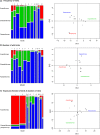Quantification of visits of wild fauna to a commercial free-range layer farm in the Netherlands located in an avian influenza hot-spot area assessed by video-camera monitoring
- PMID: 31587498
- PMCID: PMC7079184
- DOI: 10.1111/tbed.13382
Quantification of visits of wild fauna to a commercial free-range layer farm in the Netherlands located in an avian influenza hot-spot area assessed by video-camera monitoring
Abstract
Free-range poultry farms have a high risk of introduction of avian influenza viruses (AIV), and it is presumed that wild (water) birds are the source of introduction. There is very scarce quantitative data on wild fauna visiting free-range poultry farms. We quantified visits of wild fauna to a free-range area of a layer farm, situated in an AIV hot-spot area, assessed by video-camera monitoring. A total of 5,016 hr (209 days) of video recordings, covering all 12 months of a year, were analysed. A total of 16 families of wild birds and five families of mammals visited the free-range area of the layer farm. Wild birds, except for the dabbling ducks, visited the free-range area almost exclusively in the period between sunrise and the moment the chickens entered the free-range area. Known carriers of AIV visited the outdoor facility regularly: species of gulls almost daily in the period January-August; dabbling ducks only in the night in the period November-May, with a distinct peak in the period December-February. Only a small fraction of visits of wild fauna had overlap with the presence of chickens at the same time in the free-range area. No direct contact between chickens and wild birds was observed. It is hypothesized that AIV transmission to poultry on free-range poultry farms will predominantly take place via indirect contact: taking up AIV by chickens via wild-bird-faeces-contaminated water or soil in the free-range area. The free-range poultry farmer has several possibilities to potentially lower the attractiveness of the free-range area for wild (bird) fauna: daily inspection of the free-range area and removal of carcasses and eggs; prevention of forming of water pools in the free-range facility. Furthermore, there are ways to scare-off wild birds, for example use of laser equipment or trained dogs.
Keywords: avian influenza; ducks; free-range poultry; gulls; water pools; wild fauna.
© 2019 The Authors. Transboundary and Emerging Diseases published by Blackwell Verlag GmbH.
Conflict of interest statement
The authors declare no conflict of interest.
Figures







Similar articles
-
Limited transmission of avian influenza viruses, avulaviruses, coronaviruses and Chlamydia sp. at the interface between wild birds and a free-range duck farm.Vet Res. 2025 Feb 8;56(1):36. doi: 10.1186/s13567-025-01466-3. Vet Res. 2025. PMID: 39923111 Free PMC article.
-
Genetic analysis identifies potential transmission of low pathogenic avian influenza viruses between poultry farms.Transbound Emerg Dis. 2019 Jul;66(4):1653-1664. doi: 10.1111/tbed.13199. Epub 2019 Apr 25. Transbound Emerg Dis. 2019. PMID: 30964232 Free PMC article.
-
Seasonal risk of low pathogenic avian influenza virus introductions into free-range layer farms in the Netherlands.Transbound Emerg Dis. 2021 Jan;68(1):127-136. doi: 10.1111/tbed.13649. Epub 2020 Jun 7. Transbound Emerg Dis. 2021. PMID: 32506770 Free PMC article.
-
Avian influenza A viruses in birds --an ecological, ornithological and virological view.Dtsch Tierarztl Wochenschr. 2005 Dec;112(12):448-56. Dtsch Tierarztl Wochenschr. 2005. PMID: 16425630 Review.
-
[Avian influenza: eradication from commercial poultry is still not in sight].Tijdschr Diergeneeskd. 2004 Dec 1;129(23):782-96. Tijdschr Diergeneeskd. 2004. PMID: 15624878 Review. Dutch.
Cited by
-
Nanopore MinION Sequencing Generates a White Spot Syndrome Virus Genome from a Pooled Cloacal Swab Sample of Domestic Chickens in South Africa.Microorganisms. 2023 Nov 18;11(11):2802. doi: 10.3390/microorganisms11112802. Microorganisms. 2023. PMID: 38004813 Free PMC article.
-
Quantification and characterisation of commensal wild birds and their interactions with domestic ducks on a free-range farm in southwest France.Sci Rep. 2022 Jun 13;12(1):9764. doi: 10.1038/s41598-022-13846-2. Sci Rep. 2022. PMID: 35697735 Free PMC article.
-
Welfare issues and potential solutions for laying hens in free range and organic production systems: A review based on literature and interviews.Front Vet Sci. 2022 Aug 5;9:952922. doi: 10.3389/fvets.2022.952922. eCollection 2022. Front Vet Sci. 2022. PMID: 35990274 Free PMC article. Review.
-
Potential biosecurity breaches in poultry farms: Presence of free-ranging mammals near laying-hen houses assessed through a camera-trap study.Vet Anim Sci. 2024 Aug 26;26:100393. doi: 10.1016/j.vas.2024.100393. eCollection 2024 Dec. Vet Anim Sci. 2024. PMID: 39290683 Free PMC article.
-
Monitoring Wind-Borne Particle Matter Entering Poultry Farms via the Air-Inlet: Highly Pathogenic Avian Influenza Virus and Other Pathogens Risk.Pathogens. 2022 Dec 14;11(12):1534. doi: 10.3390/pathogens11121534. Pathogens. 2022. PMID: 36558868 Free PMC article.
References
-
- Australian Egg Corporation Limited (AECL) (2018). AECL annual report 2018. North Sydney, NSW, Australia: Retrieved from https://www.australianeggs.org.au/who-we-are/annual-reports/
-
- Australian Government ‐ Department of Agriculture, Fisheries and Forestry (AGDAFF) (2009). National farm biosecurity manual, poultry production. Retrieved from http://www.agriculture.gov.au/pests-diseases-weeds/protect-animal-plant/...
-
- BCG . (2018). Bird Control Group (BCG), Delft, The Netherlands. Retrieved from http://birdcontrolgroup.com
MeSH terms
Grants and funding
LinkOut - more resources
Full Text Sources
Medical

